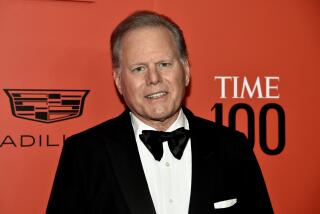The Title Game : Mergers and restructurings are leaving more leaders with honorifics fit for a Defender of the Faith.
- Share via
When Britannia dominated the globe, Victoria ruled, by the Grace of God, as queen of the United Kingdom of Great Britain and Ireland, Defender of the Faith and Empress of India.
Today, some of America’s corporate empire builders could give her a run for her money. Highfalutin titles have proliferated in the upper ranks of major corporations in the wake of the merger, acquisition and consolidation wave of the late 1980s, according to a recent study by Thorndike Deland Associates, a New York headhunting firm.
And at the very top of the corporate ladder, the study says, some chief executives have glommed onto enough honorifics to satisfy even the most pretentious of potentates.
“J. P. Morgan would stir in his grave if he had to decipher the corporate organization charts of today’s major companies,” said Louis A. Hoyda, an executive search consultant at Thorndike Deland.
The study of executive titles at 333 of the Fortune 500 firms found that from 1984 to 1988, the number of “vice chairmen” grew 15%. There were 10% more “chairmen” with extra titles even though the number of chairmen overall shrank by 18%.
The top titlist? R. Eugene Cartledge--chairman of the board, chairman of the executive committee, president and chief executive of Union Camp Corp., a paper products maker based in Wayne, N.J.
Cartledge doesn’t flaunt his titular splendor. “It’s unusual, and he doesn’t like it,” said Alexander Calder III, a Union Camp spokesman. “He doesn’t want his epaulets too damn big.”
With so many titles to choose from, what do Union Camp employees call their leader? “Gene,” Calder said.
The Thorndike Deland study discovered a big increase in what Hoyda calls “made-to-order” titles. Typically the product of mergers or acquisitions, these are the titles that salve the egos of executives who lose out to their counterparts in the other half of the merger but whom the new company wants to keep on board, Hoyda explained.
Thus, he said, an extra controller becomes “vice president, operations analysis and planning.” Or the executive vice president who fails in the battle to become vice chairman of the board becomes simply “vice chairman,” without a seat on the board at all.
Also proliferating are chairmanships within units of a company, Hoyda said. “What does the chairman of a unit have to do?” he asked. “There’s no board.”
Some of the title inflation makes good business sense, according to Edward E. Lawler, director of the Center for Effective Organizations at USC. As divisions of a company increasingly are looked upon as autonomous businesses or profit centers, it’s not unreasonable for them to be headed by “presidents,” Lawler said.
He doesn’t rule out a more banal motivation, however--the “my title is bigger than your title” syndrome, it might be called.
“There’s an almost insatiable desire on the part of senior management to progress, both in status and in wealth,” Lawler said. “Part of what’s going on in the title world is roughly what’s gone on in the compensation world--and that’s ‘more for me.’ ”
Other experts in corporate organization say companies have been experimenting with new forms--nominally, at least--of shared leadership.
“There are more twosomes or threesomes or sometimes foursomes who are forming ‘the office of the chairman’ or ‘the office of the president’ or ‘the office of the CEO,’ ” noted Donald C. Hambrick, director of the Executive Leadership Research Center at Columbia University’s Graduate School of Business in New York. Tag-team leadership--two presidents or two chairmen--has occasionally come into vogue, too, Hambrick said.
Chrysler Corp.’s experiment with dual presidents--one in charge of product and marketing, the other in charge of operations--is in its 13th month. Already it has outlasted Cigna Corp.’s attempt to operate with co-chief executives after the company was created in the merger of Connecticut General and INA in 1982.
That lasted a year.
“It’s an inherently unstable situation,” Hambrick said. “A company needs a CEO, a figurehead. Even though we don’t want our executives to be dominating, we still like them to tower.”
Towering, however, can be a precarious thing. Until last fall, James F. McDonald was in the running for most-titled American executive. He was chairman, chief executive, president, and chief operating officer of Gould Inc., the diversified electronics company based in Rolling Meadows, Ill.
Then Nippon Mining swooped in and bought Gould. The new chairman gets his mail in Tokyo. And McDonald? He’s just another “consultant to management.”
DR, JOE CRABTREE / for The Times
More to Read
Sign up for Essential California
The most important California stories and recommendations in your inbox every morning.
You may occasionally receive promotional content from the Los Angeles Times.













